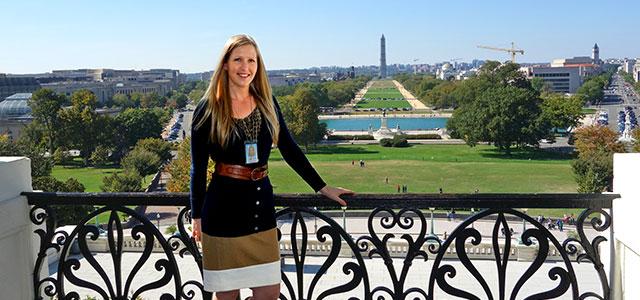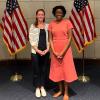
Brooke Hollister in Washington, DC
Gaining Policy Experience in the Belly of the Beast
The last few years of health care debates have made clear how deep and lasting an impact policy decisions can have on the health of a nation and on the people and institutions delivering care.
Few at UC San Francisco understand this better than Brooke Hollister, who spent much of 2013 as a Health and Aging Policy fellow in the office of Nancy Pelosi, Democratic leader of the US House of Representatives.
Now, Hollister is bringing that experience back to California and UCSF. As a faculty member in the Institute for Health & Aging at UC San Francisco School of Nursing, Hollister is helping the state and the health sciences institution understand how to shape and implement policy-related efforts that affect some of California’s most vulnerable populations.
Experience and Optimism in Washington
During her time in Washington, Hollister worked closely with Pelosi’s senior policy advisor on health and budget, Wendell Primus, focusing on a variety of health policy issues, including implementation of the Affordable Care Act, long-term care, Medicare, Medicaid and Social Security.
While Hollister experienced Washington dysfunction firsthand, she says, “Some of the things I saw actually led me to be quite optimistic, especially the incredible quality and dedication of staff members.”
She adds that Primus – who has been active in Washington, DC, since 1976 – made sure she experienced many different facets of the policy process, from constituent meetings and congressional hearings to party policy meetings and bicameral discussions on health with the Department of Health and Human Services.
“It was a lot of exposure, and I’m still sorting through the wealth of information and opportunities,” says Hollister.
But one clear lesson she took away is how essential communication skills are for anyone interested in using policy to drive important changes in health care and beyond.
“You have to boil down important concerns to bite-size talking points that convey the whole truth,” she says, noting that busy legislators and staff are bombarded with pleas from every direction and on every possible topic.
But the learning curve for being concise and effective can be steep. The first time she drafted a memo for Pelosi, it took Hollister two weeks to get it right. On her last day on the job, she wrote three similar memos over the course of a few hours.
Part of the challenge, she says, lies in having to address concerns like arcane government budgets and voter influence that are not in the comfort zone of every researcher. “But being blind to those realities makes research as stuck in the mud as the members themselves,” says Hollister. If researchers want their work to have an impact, they have to learn to use language that policymakers can relate to quickly.
“In an introductory email, you can’t take three paragraphs to say what you need and why the staff member should care – and usually you can’t resort to tugging on heartstrings as your only strategy, because staff members get 300 emails a day like that.” Thus talking about cost implications and the number of voters who care about an issue tends to be a more effective approach.
While Hollister has long understood the need for focused communication, she says, “During my time in Washington, my methods became more refined as I understood better which issues had a real chance for policy change and which didn’t.”
Putting the Experience to Work
Since her return, Hollister has become involved in a few important and far-reaching health initiatives.
Cal MediConnect is one of a series of federal demonstration projects across 11 states that explore better and more efficient ways to serve people whose health care needs are covered by two federal programs: Medicaid (Medi-Cal in California) and Medicare.
Known as “dual eligibles,” these individuals often have a complex array of long-term care, mental health and general medical needs. According to the Cal MediConnect website, the program offers dual eligibles “coordinated medical, behavioral health, long-term institutional, and home- and community-based services through a single organized delivery system.”
Such coordination is of particular interest now, because it’s generally believed that its absence has compromised the health of the dual eligibles while costing state and federal governments more than many feel is necessary.
Hollister has been part of a multicampus team (UCSF and UC Berkeley) working on a planning grant to design an evaluation of the Cal MediConnect program. Based on input from stakeholders including policymakers, health plans, care providers and consumer advocates, this team is making recommendations for an in-depth evaluation of the Cal MediConnect program.
Training Care Managers to Address the Needs of Dementia Patients
Among its many components, the Cal MediConnect demonstration offers incentives for health plans and insurers to rethink and implement a level and type of care management that is very different from the utilization management those organizations have been practicing since the early days of managed care.
With that in mind, Hollister is conducting research that examines how to effectively train both paid care managers and informal caregivers to work with people experiencing cognitive decline.
One project emerged from a Cooperative Agreement with the US Bureau of the Health Professions to establish a UCSF Health Workforce Research Center (HWRC). Led by School faculty Joanne Spetz and Susan Chapman, the center is examining the supply, demand, distribution and capacity of the health care workforce to meet the needs of older adults and persons with disabilities.
That workforce includes care managers working with the dual-eligible population, but there is a dearth of information about what training those managers need to work effectively with dementia patients and their families. Spetz and Chapman realized Hollister had expertise in this area and have asked her to contribute to a report that examines how each of the 11 dual-eligible demonstrations are accommodating beneficiaries with dementia – and whether the accommodations are proving to be effective.
In a related project, Hollister is partnering with the Alzheimer’s Association to evaluate the efficacy of a training protocol for care managers that the Alzheimer’s Association has developed – and which many of the federal demonstration projects are using.
“Until now, up-front costs prevented [health plans from] investing [in this type of training], but now we have an incentive from the government for health plans to put the training into place and share in any savings,” says Hollister. “That helps health plans be innovative; they may find that offering families a ride to the doctor’s office might be a better option than an [eventual] ambulance.”
Finally, Hollister is also working with the Alzheimer’s Association on a community-based participatory research project to examine the impact of giving informal caregivers training in how to better care for their loved ones. By examining both qualitative and quantitative data, Hollister hopes to help resolve some disagreements about whether or not such training makes enough of a difference for health plans and insurers to invest in it.
A Resource at UCSF
In addition to her specific policy work, Hollister has volunteered to share what she learned during her time in Washington with researchers across UCSF. “When I came back, I spoke with many of my colleagues and mentors about what kind of opportunities there were for me to be a resource for other faculty members,” says Hollister. “You hate to see people not get grants because they don’t have policy experience or don’t know how to take advantage of some of the people UCSF has in Washington, who are fabulous.”
In addition to the experience she gained, Hollister developed a network of important contacts, but she notes that drawing on those networks can present ethical challenges, which researchers need to navigate very carefully. She adds that she found the researchers who were most successful in Washington pair an ability to make their voice heard with the ability to ensure that staff members and journalists not misstate or misuse the implications of a particular piece of research.
“It’s complicated, because quite often the researchers are advocating for their life’s work, and they’re addressing a huge and valid problem,” says Hollister. “Knowing when and how to get your work noticed without tarnishing yourself or your work takes a lot of discipline.”



